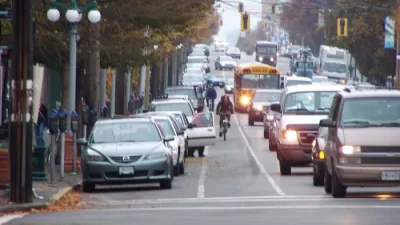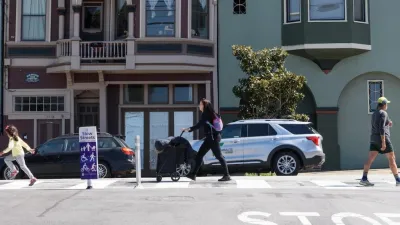More and more local governments are adopting complete streets policies. But gaps in implementation in these places suggests that the building of actual complete streets is dependent on a true culture shift. Angie Schmitt looks at the obstacles.
"If Ontario Street in Cleveland, Ohio, is any indication, a complete streets policy is no guarantee you’ll get a safe place to ride a bike, or even a comfortable place to walk." Cleveland is one of the 500 communities and states across the country with a complete streets policy on the books. But when the city recently resurfaced eight-lane Ontario Street, the only nod to the policy enacted by the traffic engineering department was the addition of "shared lane bike stencils, or sharrows."
"And there you have it," says Schmitt. "A complete streets policy should be a fabulous thing that elevates safety, the economy, and social equity in cities, but it can also amount to nothing more than a few new rules that are easily ducked if officials don’t want to follow the spirit of the law."
"Having good city staff — people who are committed to seeing complete streets implemented and understand why it’s important — is crucial. Or, like Charlotte, you can develop and train a working group or committee to oversee the process."
“You have a lot of people that have been around for years that are used to doing things the way they have been doing them,” Stefanie Seskin at the National Complete Streets Coalition said. “You have to change the problem and make them understand they’re solving for a new problem.”
FULL STORY: Passing a Law Is the Easy Part: The Challenge of Building Complete Streets

Alabama: Trump Terminates Settlements for Black Communities Harmed By Raw Sewage
Trump deemed the landmark civil rights agreement “illegal DEI and environmental justice policy.”

Planetizen Federal Action Tracker
A weekly monitor of how Trump’s orders and actions are impacting planners and planning in America.

Why Should We Subsidize Public Transportation?
Many public transit agencies face financial stress due to rising costs, declining fare revenue, and declining subsidies. Transit advocates must provide a strong business case for increasing public transit funding.

Understanding Road Diets
An explainer from Momentum highlights the advantages of reducing vehicle lanes in favor of more bike, transit, and pedestrian infrastructure.

New California Law Regulates Warehouse Pollution
A new law tightens building and emissions regulations for large distribution warehouses to mitigate air pollution and traffic in surrounding communities.

Phoenix Announces Opening Date for Light Rail Extension
The South Central extension will connect South Phoenix to downtown and other major hubs starting on June 7.
Urban Design for Planners 1: Software Tools
This six-course series explores essential urban design concepts using open source software and equips planners with the tools they need to participate fully in the urban design process.
Planning for Universal Design
Learn the tools for implementing Universal Design in planning regulations.
Caltrans
Smith Gee Studio
Institute for Housing and Urban Development Studies (IHS)
City of Grandview
Harvard GSD Executive Education
Toledo-Lucas County Plan Commissions
Salt Lake City
NYU Wagner Graduate School of Public Service




























